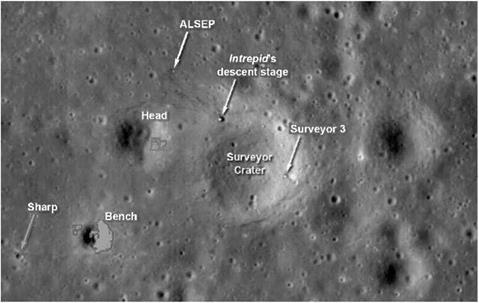At first glance, this episode after Apollo 15’s docking might appear to be a comedy of errors by both the crew and MOCR. yet it indicates how. in an environment that is extremely unforgiving, a safe and successful outcome was achieved. Scott
recognised that the separation burn was unsafe (probably because of the extra revolution around the Moon), brought it to the MOCR’s attention and proceeded to carry on, trusting the people on the ground to assess the situation correctly.
This illustrates the close relationship between a crew and mission control. The people in Houston had a very high visibility into the spacecraft, its systems and its trajectory by virtue of telemetry, available computing power and the knowledge and experience of the entire team in the control centre. The crew had a high situational awareness by virtue of having their eyes and ears in situ so to speak. The two sides then worked together to fulfil the mission’s objectives. This was an extension of the aviation model where the pilot in command of an aircraft works with air traffic control to ensure safe travel in what is a very unforgiving medium. In a sense, both are in collaborative control, linked in their common purpose by the air/ground communications loop. Rarely do the two get out of phase and when they do, it is usually down to the quality of communication on this loop.
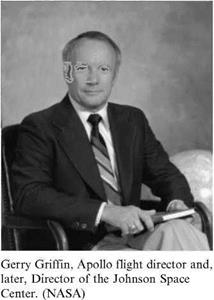 Gerry Griffin, one of Apollo 15’s flight directors, and later director of the Johnson Space Center, made this very point. "In aviation, pilots don’t control what goes on in the airspace, they control their aircraft by a set of rules and by following instructions from the various control facilities who also operate under certain rules. For sure, the aircraft commander can take any action he or she deems necessary to safely operate the aircraft, including disobeying an instruction from an air traffic control centre, approach control, or a control tower. As soon as the aircraft commander takes that overriding step, he or she will have a lot of explaining to do when they get on the ground, and if they can’t convince the powers-that-be that they took the proper course of action given the conditions, they won’t be flying anymore, or at least, they won’t be flying for a long while. It is no different in the American manned space flight environment. Like the aviation analogy, the commander in Mercury-Gemini-Apollo controlled the spacecraft and could take any step he felt necessary to operate the spacecraft safely and to finish the task at hand in accordance with the flight plan and mission rules. Those of us in the mission control centre [MCC] understood that fully and agreed with it. But when any out-of-the-ordinary situation reached a ‘safe harbour’ or stopping point, the commander or crew was expected to (and always did) work closely with the MCC to proceed on with the mission. Often the ‘next steps’ were ‘directive’ in nature and emanated from MCC.”
Gerry Griffin, one of Apollo 15’s flight directors, and later director of the Johnson Space Center, made this very point. "In aviation, pilots don’t control what goes on in the airspace, they control their aircraft by a set of rules and by following instructions from the various control facilities who also operate under certain rules. For sure, the aircraft commander can take any action he or she deems necessary to safely operate the aircraft, including disobeying an instruction from an air traffic control centre, approach control, or a control tower. As soon as the aircraft commander takes that overriding step, he or she will have a lot of explaining to do when they get on the ground, and if they can’t convince the powers-that-be that they took the proper course of action given the conditions, they won’t be flying anymore, or at least, they won’t be flying for a long while. It is no different in the American manned space flight environment. Like the aviation analogy, the commander in Mercury-Gemini-Apollo controlled the spacecraft and could take any step he felt necessary to operate the spacecraft safely and to finish the task at hand in accordance with the flight plan and mission rules. Those of us in the mission control centre [MCC] understood that fully and agreed with it. But when any out-of-the-ordinary situation reached a ‘safe harbour’ or stopping point, the commander or crew was expected to (and always did) work closely with the MCC to proceed on with the mission. Often the ‘next steps’ were ‘directive’ in nature and emanated from MCC.”
One of the important differences from the air traffic analogy is the visibility
|
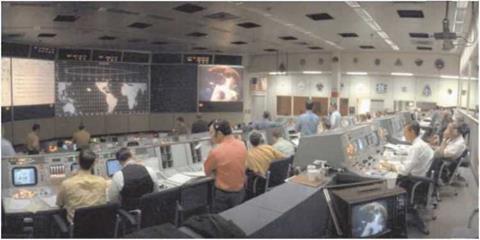
Mission control during Apollo 14’s docking problems. (NASA)
|
mission control has into so many of the spacecraft’s systems. Air traffic control looks at the movements of many aircraft all at once but cannot diagnose an impending technical problem in a single aircraft. Apollo’s mission control, on the other hand, while having no other spacecraft to worry about, could see far more detail about its health than the crew could, and could bring much more brainpower to any situation. Throughout an Apollo flight, there were many times when a decision from mission control was vital to the progression of the mission, typified by the ‘Go/no-Go’ call which became a media catchphrase of the MOCR, for example, before ТІЛ, LOI and the final decision to land on the Moon (PDI), as Griffin explained:
"The MCC had to make sure the ground-based systems and the systems the crew couldn’t see (for example, the S-IVB before TLI, or the command module before PDI) were ready. Then, we unequivocally told them that we were Go, or no-Go. If the MCC and the crew were Go, the crew was expected to carry out the ‘next step’. Of course, similar to the aviation analogy, the commander or crew could hold off perfonning one of those milestone events even after we both had agreed it was Go if they didn’t like something they saw. If they were right, so be it – good catch – but they had better be right.”
The Mission Control Center evolved during the 1960s through the Mercury and Gemini programmes, beginning with Chris Kraft as the model for the flight director. He defined this role, and also that of mission control and the crew. Around him, the very best engineers and specialists were brought together, some in the MOCR, others in outlying rooms and buildings or at contractors’ premises, able to coordinate and run a normal mission, and to react to and troubleshoot an anomalous one.
During Apollo, international TV coverage of the astronauts at their work was often interspersed with a wide-angle shot of the MOCR during periods when no pictures were available from the spacecraft. Images of serious-looking people in shirt and tie, seated at high-tech consoles where screens flickered and lights blinked, became part of
the public mythology of American spaceflight. Л generation later, the imagery of astronauts and mission control turns up in such movies as Contact, Deep Impact and. of necessity, in Apollo 13. But, as is often the case, this is an incomplete image. Gerry Griffin advised on the making of some of these movies and even took a cameo role as a flight controller. But he believes this public imagery needs to be put into perspective.
“The astronauts didn’t run the Apollo programme, neither did the flight controllers, and neither of the two were totally responsible for the success of Apollo. The Apollo programme was run by a very capable bunch of guys-on-the-ground who managed the funding for. and the building of. the flight and ground hardware. These same guys also got the agency enough money to hire the best people in the world at NASA and its contractors to do the work including astronauts and flight controllers. The MCC included all of these guys-on-the-ground, not just the flight controllers from the Flight Control Division at [the Manned Spacecraft Center, later renamed as the Johnson Space Center]. When a decision was made by the entire team on the ground it was always discussed with the crew for their input, adjusted if necessary, then implemented. While the astronauts and flight controllers got most of the visibility in Apollo, we both were actually very small, albeit very important, parts of the programme.”
The most important lesson to take from how Apollo managed to operate so well, was that it represented the epitome of teamwork. The commander and his crew have the situational awareness at the sharp end of the operation, while the personnel at mission control have a far wider knowledge of the context within which the flight is flown. David Scott commented on this in later years:
“Mission control doesn’t have any control over the spacecraft, so it’s “mission advisory’. It’s like air traffic control; they control the airspace but they don’t control the airplane. They advise the airplane and the pilot is accountable for all of his actions and that’s basically the way the system works. Who’s in command and who’s in control and who’s advisory – it’s a team kind of thing. Everybody has to work. You have to balance the situational awareness with the advice from MCC because they have much more data to look at so their advice is invaluable to the situational decision. But it’s not a command. Some people in management and MCC would consider it a command, but that’s OK. The commander, in a situation, sometimes has to override the words that he gets from MCC in order to complete the objectives for w’hich he’s responsible."
Having crews that were mostly derived from military and test flying affected the melding of the crew/controller relationship. These w’ere people who w’ere used to fulfilling orders and getting the job done in association with controllers, yet able to cope at the sharp end of aircraft command in sometimes difficult situations, as Scott explained: “Another mindset of those of us who were flying during those days was that wc had a lot of flight experience alone in airplanes where we had to make decisions. If you don’t have that, then you probably have a more open mindset to MCC’s instructions or advice. In other words, if you haven’t been in these situations where you got bad advice or had to make decisions on your own in flight, then you would rely more totally on MCC because you don’t have this experience of needing to do your own decisions on all the data.”
|
Mission control during the launch of Apollo 15. (NASA)
|
We will leave it to Gerry Griffin to sum up why NASA’s mission control worked so well: “Simply stated, it was the best flight operations team ever assembled. It was built on respect, trust and teamwork. The flight crews and flight controllers were a tight bunch who trusted each other to do the right thing. The only time it didn’t work, and work extremely well, was Apollo 7; and even at that, the mission turned out to be a huge success.”











 As he prepared the rover for their first traverse, David Scott noticed that the newly installed camera was following his every move. "Gee, you’re watching me flounder around out here.” He later recounted the moment he and frwin realised they were not really alone on the Moon.
As he prepared the rover for their first traverse, David Scott noticed that the newly installed camera was following his every move. "Gee, you’re watching me flounder around out here.” He later recounted the moment he and frwin realised they were not really alone on the Moon.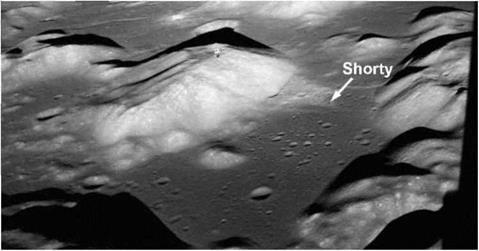
 Gerry Griffin, one of Apollo 15’s flight directors, and later director of the Johnson Space Center, made this very point. "In aviation, pilots don’t control what goes on in the airspace, they control their aircraft by a set of rules and by following instructions from the various control facilities who also operate under certain rules. For sure, the aircraft commander can take any action he or she deems necessary to safely operate the aircraft, including disobeying an instruction from an air traffic control centre, approach control, or a control tower. As soon as the aircraft commander takes that overriding step, he or she will have a lot of explaining to do when they get on the ground, and if they can’t convince the powers-that-be that they took the proper course of action given the conditions, they won’t be flying anymore, or at least, they won’t be flying for a long while. It is no different in the American manned space flight environment. Like the aviation analogy, the commander in Mercury-Gemini-Apollo controlled the spacecraft and could take any step he felt necessary to operate the spacecraft safely and to finish the task at hand in accordance with the flight plan and mission rules. Those of us in the mission control centre [MCC] understood that fully and agreed with it. But when any out-of-the-ordinary situation reached a ‘safe harbour’ or stopping point, the commander or crew was expected to (and always did) work closely with the MCC to proceed on with the mission. Often the ‘next steps’ were ‘directive’ in nature and emanated from MCC.”
Gerry Griffin, one of Apollo 15’s flight directors, and later director of the Johnson Space Center, made this very point. "In aviation, pilots don’t control what goes on in the airspace, they control their aircraft by a set of rules and by following instructions from the various control facilities who also operate under certain rules. For sure, the aircraft commander can take any action he or she deems necessary to safely operate the aircraft, including disobeying an instruction from an air traffic control centre, approach control, or a control tower. As soon as the aircraft commander takes that overriding step, he or she will have a lot of explaining to do when they get on the ground, and if they can’t convince the powers-that-be that they took the proper course of action given the conditions, they won’t be flying anymore, or at least, they won’t be flying for a long while. It is no different in the American manned space flight environment. Like the aviation analogy, the commander in Mercury-Gemini-Apollo controlled the spacecraft and could take any step he felt necessary to operate the spacecraft safely and to finish the task at hand in accordance with the flight plan and mission rules. Those of us in the mission control centre [MCC] understood that fully and agreed with it. But when any out-of-the-ordinary situation reached a ‘safe harbour’ or stopping point, the commander or crew was expected to (and always did) work closely with the MCC to proceed on with the mission. Often the ‘next steps’ were ‘directive’ in nature and emanated from MCC.”
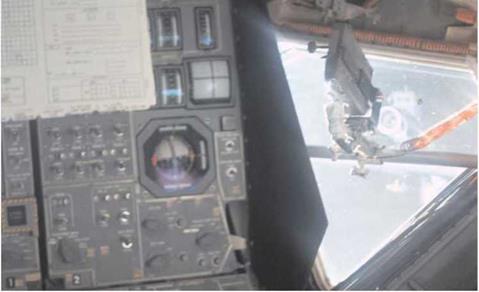
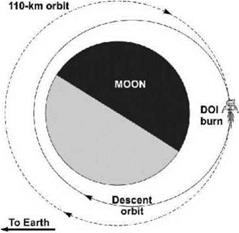
 “Intrepid, Houston. Looking good at two,” replied Carr as they passed the 2-minute mark into the burn.
“Intrepid, Houston. Looking good at two,” replied Carr as they passed the 2-minute mark into the burn.